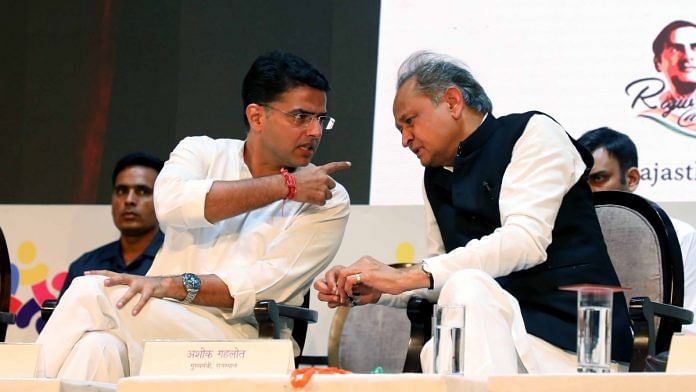Are two leaders better than one? While traditional wisdom suggests that a single strong leadership is superior, the Congress in Karnataka and Rajasthan has been grappling with a difficult situation of managing two near-equal leaders. For now, the dust is settling down in Karnataka with the finalisation of Siddaramaiah as the chief minister and DK Shivakumar as the deputy chief minister but the storm is still brewing in the desert state between CM Ashok Gehlot and Sachin Pilot.
The concept and practice of equal or near equal leadership in the political realm find resonance in the co-CEO model of the corporate world. In fact, the idea traces back to the role of co-consuls prevalent in Ancient Rome. In India, there have been fewer cases of co-CEOs over the years. Mukesh Ambani and Anil Ambani in the undivided Reliance group in the 1990s and the current leadership of Kailash Kulkarni and Ravi Menon at HSBC Mutual Fund come to mind. However, this model has successfully worked in global corporations like Unilever, Goldman Sachs, Oracle, Warburg Pincus, KKR & Co Inc. and Jeffries Financial Group.
A 2022 Harvard Business Review (HBR) article cites a study of 87 companies where co-CEOs worked well with each other to generate higher than average shareholder returns as compared to companies with a single CEO. These global corporations have lessons for Indian political parties on the art and science of co-leadership.
Successful power-sharing and partnership depend on a host of factors, but we will look at three most important ones. These include: commitment to the idea and complementary skill sets; developing trust among the two leaders and shared responsibilities in an increasingly complex world.
Also read: Not just brother vs brother. Bharat Forge to Hinduja, women are fighting for family business
Idea and skill sets
To recall the times at Reliance Industries where the two Ambani brothers were up in arms at each other, it would be difficult to believe that they once ran the company as co-CEOs for several years Mukesh overlooked the large and complex manufacturing operations, while Anil dived deep into roles that required external relations like marketing and fundraising. But there was an equally important factor for the success: the larger-than-life presence of the founder Dhirubhai Ambani.
Private equity firm Warburg Pincus was run jointly for two long decades by Lionel Pincus and John Vogelstein. Pincus raised the funds and Vogelstein invested them. A key takeaway is that the more distinct the skills of each co-CEO, the better it is for the company.
Trust and friendship
At Netflix, Ted Sandaros and Greg Peters are co-CEOs. Reed Hastings, founder and executive chairman of Netflix in a message said that Peters and Sandaros have developed great trust and respect for each other through their collective successes and failures. “These qualities — combined with their complementary skill sets, deep knowledge of entertainment and technology, and proven track record at Netflix — has created a unique opportunity to deliver faster growth and greater success long term with them as co-CEOs.”
Private equity and global investment major KKR & Co is another great example. The company is run by Joseph Bae and Scott Nuttall. That they knew each other much before they joined the firm has helped. Their friendship started in college, they joined KKR together, their nine kids (Nuttall with five and Bae with four) studied and played together and their spouses are also good friends. Bae and Nuttall both love McDonald’s burgers. Before they took up the role of co-CEOs, they were co-presidents at the same firm. They have been together in the firm for 25 years. What has also helped at a macro level is that KKR’s co-founders Henry Kravis and George Roberts were also co-CEOs before they handed the baton to Bae and Nuttall. KKR fosters a culture of co-leadership.
Also read: Sachin Pilot has DK Shivakumar and Siddaramaiah to thank—their tussle gave him TV airtime
No place for ego
The global economy is only getting more complex and therefore, today, two leaders are perhaps better than one in many instances. Global corporations will find it increasingly difficult to manage the diversity and flux. Therefore, co-CEOs might well work best for the larger benefit of the company. Dividing the turf with clear demarcations by geography or verticals is one way to manage the division of responsibilities. It has also been seen that when the top leadership responsibilities are split, the teams below them also sync in with greater cohesion.
An interesting example from India was the acquisition and merger of L&T Investment Management into HSBC Asset Management to create a single company in November 2022. L&T Investment Funds CEO Ravi Menon became the co-CEO of the merged entity along with Kailash Kulkarni who was already heading the HSBC group. At that time, Hitendra Dave, CEO of HSBC India had said, “We are hungry for growth in India. This move gives us the scale, reach and capabilities to capture the growing asset management market in India.” In short, through the creation of Co-CEOs, HSBC decided to “divide and conquer.”
Jayaram Easwaran, management consultant and author of the best-selling book, Inside the C-Suite, sums up, “There are many lessons for political leaders from the co-CEO model in companies. One of the most important of them is that the leaders should have a larger purpose and the big picture in mind. Individual egos should not be given a place.”
The co-CEO model is a promising idea that should receive greater attention.
The writer is a former editor at the Indian School of Business. Views are personal.
(Edited by Ratan Priya)



